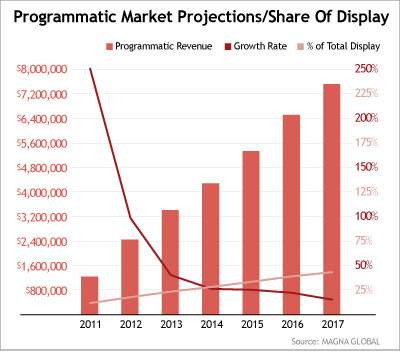Real-Time Trading Emerges As Second-Fastest Ad Sector, Limited Only By Its Inability To Crack Mobile
- by Joe Mandese @mp_joemandese, January 14, 2013

The good news is that programmatic trading has emerged as the second fastest-growing segment of the advertising marketplace. The bad news is
that it is the problems it has been having tapping into the fastest-growing segment -- mobile -- that is limiting programmatic’s growth. That’s one of the key findings from Magna
Global’s third-quarter Media Economy Report.
While ad spending on mobile media will average an annual growth rate of 30.6% through 2017, programmatic trading will expand only 25%
annually due to some significant impediments preventing it from tapping into mobile’s growth.
While that’s still impressive given that Interpublic’s Magna unit projects
the overall advertising marketplace will expand only 5.2% annually over the next five years, the problems are limiting both programmatic’s and mobile’s potential, says Magna Managing
Partner-Media Intelligence Practice Brian Monahan.
Specifically, he says that it is the technical limitations of mobile’s data targeting that “currently cripple the
effectiveness of mobile programmatic buys.”
“In addition to needing real-time access to large pools of inventory, scaled programmatic buying requires the ability to identify
niche audiences as defined by third-party data providers and to retarget users who take specific online actions,” Monahan writes in the new report, which was released late last week during the
CES conference in Las Vegas.
While Web browsers enable third-party cookies to provide that data in the display advertising marketplace, a variety of factors, including the fact that
Apple’s Safari browser does not accept third-party cookies, have proven to be a major impediment to the programmatic trading of mobile ad inventory.
“Even on Android devices
with browsers that accept cookies, identification breaks as users jump between app and browser sandboxes,” the Magna report notes, adding: “Finally, there is no easy way to identify and
retarget based on PC activities. In exchange buying, a critical safeguard for brand appropriate environments is provided by ad safety vendors. In the Web they rely on web crawlers and macros delivered
with their tags by the ad server to extract information on the content and the ad placement. These techniques are not yet sufficiently robust to extract the required brand safety information from
mobile apps.”
Despite those limitations, programmatic trading is booming, even without mobile’s impetus. Magna forecasts it will grow more than 40% this year, rising to 23.2% of
all online display advertising sold. By 2017, Magna predicts programmatic trading will rise to $7.533 billion, representing 43% of all online display advertising.
Magna’s estimates
are among the most aggressive in the industry, although others are also pretty optimistic on programmatic’s growht potential. A report released last week by J.P. Morgan analyst Doug Anmuth,
citing eMarketer data, predicts that programmatic trading will expand to $4.533 billion by 2016, accounting for 28% of all display advertising that year. (Magna pegs programamtic at $6.525 billion,
and 38.7% of display by that year.)
While Anmuth does not address the mobile issues associated with programmatic trading, he says the growth of programmatic buying is propping up the online
display ad market’s growth, and will offset a slowdown in search spending, although many publishers still complain about it “commoditizing” pricing.
“We expect
desktop display advertising to increase 10% in 2013, driven in part by real-time bidding (RTB) or programmatic buying of display,” Anmuth wrote in a report sent to investors late last week.
“We believe slowing desktop search, in particular, is likely to serve as a catalyst for direct marketers to allocate a greater percentage of their budgets towards RTB and performance-based
display.”
Much of that growth, Anmuth writes, is attributable to the growth of the Facebook Exchange, which is pouring untapped ad inventory into the programmatic marketplace.
“We think Facebook’s entry into RTB could make Facebook one the largest sellers of RTB inventory over time,” Anmuth predicts. “According to our checks, the Facebook Ad
Exchange (FBX) could potentially increase industry RTB inventory by 66% within the next 6-12 months.”
Interestingly, that surge won’t just benefit Facebook, but will be a
rising tide for the entire display ad exchange marketplace, including the Google Ad Exchange, the Google Display network, Yahoo’s Right Media, AOL and others.
“To provide some
perspective, Facebook accounted for 28% of all US desktop display ad impressions in 2011, according to comScore making it an important new destination for RTB advertisers to specifically re-target
individual users,” Anmuth explains, adding: “FBX was released out of beta in mid-September and now has at least 16 data and technology partners including AppNexus, DataXu, Kenshoo,
RocketFuel, Triggit, and Turn, among others. We believe the incorporation of third-party data into Facebook’s ad platform is material. For example, if a user visits an online travel site but
leaves before the check-out process, that OTA can re-target the same user on Facebook with additional messages or offers.”
Anmuth predicts that Facebook’s FBX momentum will
encourage Google, Yahoo and others to enhance their own exchange and programmatic display offerings to compete with Facebook’s massive reach and supply of inventory.




Interesting report from MAGNA, I particularly like the schematic on p. 27 that very succinctly summarizes the differences in desktop & mobile programmatic buying.
What's your view on how the industry tackles the absence of 3rd party cookies in mobile? Are there any technologies and/or companies that are likely to win out in enabling 3rd party data targeting in mobile?
And how do you think we can bridge the PC-mobile divide, i.e. retargeting users on mobile according to desktop behaviour? Will this ever be a reality?
Alastair,
Good question. Since nature abhors a vacuum, some smart companies are already working on those problems. If you look on page 35 of the report, there are a number of players rushing to develop respondent-level data for targeting and servicing mobile ads. Magna lists eight of them (including biggies like Facebook and Amazon). I don't know all of their approaches, but I've met with the Adelphic Mobile team (ex-Apple and ex-Quatro) and they're pretty smart and think they know how to deal with it.
But I agree with you, and Magna, that data will be the key to unlocking mobile ad targeting, and that it will be more complex than cookie-based browser targeting.
Thanks Joe - I read on, and yes the report lists a number of companies that are addressing the issue. Good article btw, sums up a lengthy report very well!